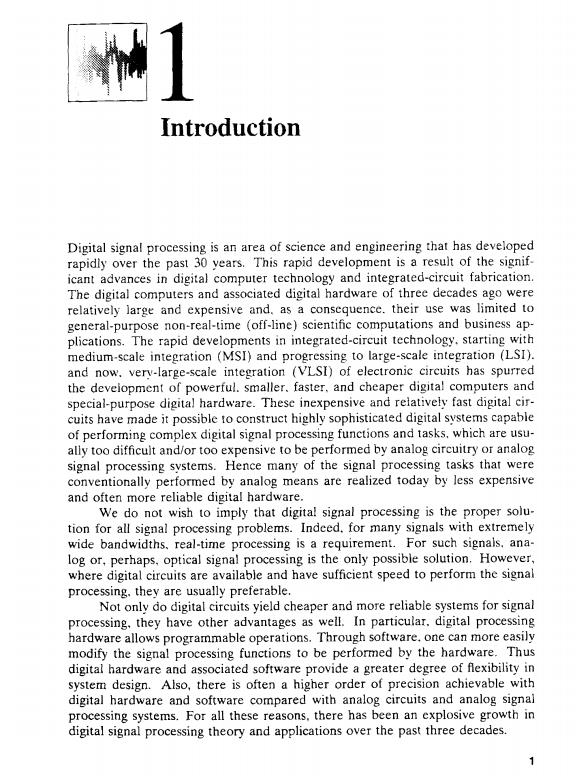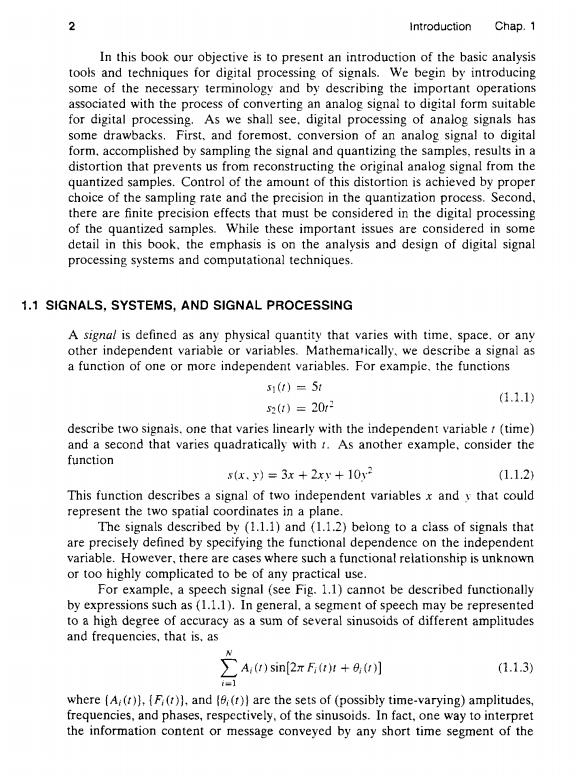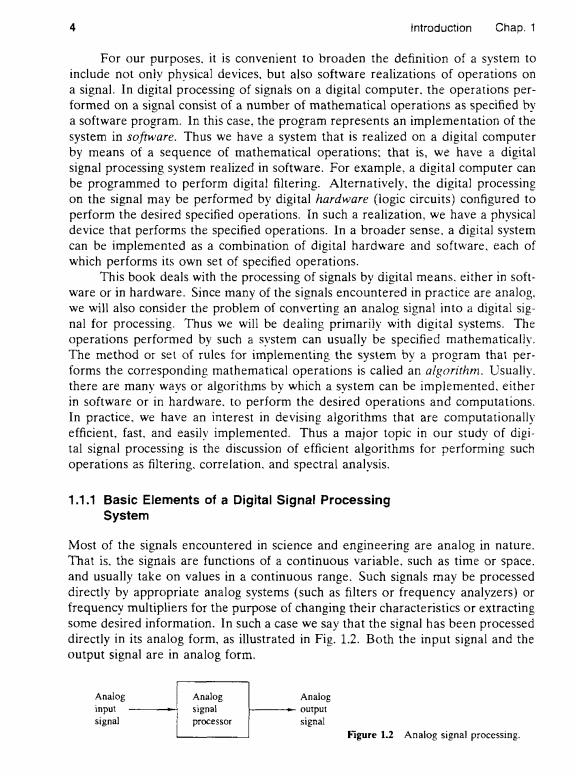

Introduction Digital signal processing is an area of science and engineering that has developed rapidly over the past 30 years.This rapid development is a result of the signif- icant advances in digital computer technology and integrated-circuit fabrication The digital computers and associated digital hardware of three decades ago were relatively large and expensive and.as a consequence.their use was limited to general-purpose non-real-time (off-line)scientific computations and business ap- plications.The rapid developments in integrated-circuit technology.starting with medium-scale integration (MSI)and progressing to large-scale integration (LSI). and now.very-large-scale integration (VLSI)of electronic circuits has spurred the development of powerful.smaller.faster.and cheaper digital computers and special-purpose digital hardware.These inexpensive and relatively fast digital cir- cuits have made it possible to construct highly sophisticated digital systems capable of performing complex digital signal processing functions and tasks.which are usu- ally too difficult and/or too expensive to be performed by analog circuitry or analog signal processing systems.Hence many of the signal processing tasks that were conventionally performed by analog means are realized today by less expensive and often more reliable digital hardware. We do not wish to imply that digital signal processing is the proper solu- tion for all signal processing problems.Indeed.for many signals with extremely wide bandwidths.real-time processing is a requirement.For such signals.ana- log or,perhaps,optical signal processing is the only possible solution.However, where digital circuits are available and have sufficient speed to perform the signal processing.they are usually preferable. Not only do digital circuits yield cheaper and more reliable systems for signal processing,they have other advantages as well.In particular.digital processing hardware allows programmable operations.Through software.one can more easily modify the signal processing functions to be performed by the hardware.Thus digital hardware and associated software provide a greater degree of flexibility in system design.Also,there is often a higher order of precision achievable with digital hardware and software compared with analog circuits and analog signal processing systems.For all these reasons.there has been an explosive growth in digital signal processing theory and applications over the past three decades. 1

2 Introduction Chap.1 In this book our objective is to present an introduction of the basic analysis tools and techniques for digital processing of signals.We begin by introducing some of the necessary terminology and by describing the important operations associated with the process of converting an analog signal to digital form suitable for digital processing.As we shall see.digital processing of analog signals has some drawbacks.First.and foremost.conversion of an analog signal to digital form.accomplished by sampling the signal and quantizing the samples,results in a distortion that prevents us from reconstructing the original analog signal from the quantized samples.Control of the amount of this distortion is achieved by proper choice of the sampling rate and the precision in the quantization process.Second, there are finite precision effects that must be considered in the digital processing of the quantized samples.While these important issues are considered in some detail in this book.the emphasis is on the analysis and design of digital signal processing systems and computational techniques 1.1 SIGNALS.SYSTEMS,AND SIGNAL PROCESSING A signal is defined as any physical quantity that varies with time.space,or any other independent variable or variables.Mathematically.we describe a signal as a function of one or more independent variables.For example.the functions 51(t)=51 (1.1.1) 52(t)=20r2 describe two signals.one that varies linearly with the independent variable t (time) and a second that varies quadratically with r.As another example,consider the function 5(x.y)=3x+2xy+10y2 (1.1.2) This function describes a signal of two independent variables x and y that could represent the two spatial coordinates in a plane. The signals described by (1.1.1)and (1.1.2)belong to a class of signals that are precisely defined by specifying the functional dependence on the independent variable.However,there are cases where such a functional relationship is unknown or too highly complicated to be of any practical use. For example,a speech signal(see Fig.1.1)cannot be described functionally by expressions such as (1.1.1).In general,a segment of speech may be represented to a high degree of accuracy as a sum of several sinusoids of different amplitudes and frequencies,that is,as Au)sin[2πFer+8,】 (1.1.3) i=1 where (A:()),(F()),and (r))are the sets of (possibly time-varying)amplitudes, frequencies,and phases,respectively,of the sinusoids.In fact,one way to interpret the information content or message conveyed by any short time segment of the

Sec.1.1 Signals,Systems,and Signal Processing 3 wwwwi- Figure 1.1 Example of a speech signal. speech signal is to measure the amplitudes.frequencies,and phases contained in the short time segment of the signal. Another example of a natural signal is an electrocardiogram (ECG).Such a signal provides a doctor with information about the condition of the patient's heart. Similarly,an electroencephalogram (EEG)signal provides information about the activity of the brain. Speech.electrocardiogram.and electroencephalogram signals are examples of information-bearing signals that evolve as functions of a single independent variabie.namely.time.An example of a signal that is a function of two inde- pendent variables is an image signal.The independent variables in this case are the spatial coordinates.These are but a few examples of the countiess number of natural signals encountered in practice. Associated with natural signals are the means by which such signals are gen- erated.For example.speech signals are generated by forcing air through the vocal cords.Images are obtained by exposing a photographic film to a scene or an ob- ject.Thus signal generation is usually associated with a system that responds to a stimulus or force.In a speech signal.the system consists of the vocal cords and the vocal tract.also called the vocal cavity.The stimulus in combination with the system is called a signal source.Thus we have speech sources.images sources,and various other types of signal sources. A systemt may also be defined as a physical device that performs an opera. tion on a signal.For example,a filter used to reduce the noise and interference corrupting a desired information-bearing signal is called a system.In this case the filter performs some operation(s)on the signal.which has the effect of reducing (filtering)the noise and interference from the desired information-bearing signal. When we pass a signal through a system,as in filtering.we say that we have processed the signal.In this case the processing of the signal involves filtering the noise and interference from the desired signal.In general,the system is charac- terized by the type of operation that it performs on the signal.For example,if the operation is linear,the system is called linear.If the operation on the signal is nonlinear.the system is said to be nonlinear,and so forth.Such operations are usually referred to as signal processing

4 introduction Chap.1 For our purposes.it is convenient to broaden the definition of a system to include not oniy physical devices,but also software realizations of operations on a signal.In digital processing of signals on a digital computer.the operations per- formed on a signal consist of a number of mathematical operations as specified by a software program.In this case.the program represents an implementation of the system in sofrware.Thus we have a system that is realized on a digital computer by means of a sequence of mathematical operations:that is,we have a digital signal processing system realized in software.For example,a digital computer can be programmed to perform digital filtering.Alternatively.the digital processing on the signal may be performed by digital hardware (logic circuits)configured to perform the desired specified operations.In such a realization,we have a physical device that performs the specified operations.In a broader sense.a digital system can be implemented as a combination of digital hardware and software.each of which performs its own set of specified operations. This book deals with the processing of signals by digital means.either in soft- ware or in hardware.Since many of the signals encountered in practice are analog. we will also consider the problem of converting an analog signal into a digital sig- nal for processing.Thus we will be dealing primarily with digital systems.The operations performed by such a system can usually be specified mathematically. The method or set of rules for implementing the system by a program that per forms the corresponding mathematical operations is calied an algorithm.Usually. there are many ways or algorithms by which a system can be implemented.either in software or in hardware.to perform the desired operations and computations. In practice.we have an interest in devising algorithms that are computationally efficient,fast,and easily implemented.Thus a major topic in our study of digi. tal signal processing is the discussion of efficient algorithms for performing such operations as filtering.correlation.and spectral analysis. 1.1.1 Basic Elements of a Digital Signal Processing System Most of the signals encountered in science and engineering are analog in nature. That is.the signais are functions of a continuous variable,such as time or space and usually take on values in a continuous range.Such signals may be processed directly by appropriate analog systems(such as filters or frequency analyzers)or frequency multipliers for the purpose of changing their characteristics or extracting some desired information.In such a case we say that the signal has been processed directly in its analog form,as illustrated in Fig.1.2.Both the input signal and the output signal are in analog form. Analog Analog Analog input signal -output signal processor signal Figure 1.2 Analog signal processing